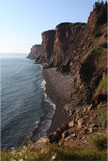Safety Messaging
In Case of Emergency: Call 911
Terrain and Weather
Participants should have adequate footwear and protection against both wet and cold, including a hat, gloves, and boots. Sturdy footwear is important as many of the trails and beaches within the Geopark are rocky/cobbly and can be very difficult to traverse, especially when wet as the rocks become slippery. Adequate clothing is important if you are involved in an accident or if you are unexpectedly required to spend an extensive period of time outdoors. Spring weather in Nova Scotia is unpredictable and can change from sunny and warm, to rain, wet snow, and high winds with little notice. When walking or hiking on trails, make sure to remain on the marked trail for your own safety and to avoid any unseen hazards, as well as preserve the environment.
It is also important to protect yourself from the sun. When exploring the beach, there are few shaded areas so always wear sunscreen, drink lots of water and wear a hat if you will be outside for an extended period of time.
Tides
The most important safety concern throughout the Geopark is the tides. The rising tide can flood parts of some tidal flats and sand bars faster than you can run. The rising tide may block your access route around a headland, creating a “pinch point”. Many coves are completely flooded at high tide, with no escape route up the steep cliffs.
A general rule of thumb is to plan to return to your vehicle two hours before high tide, three hours before if you have passed headlands that will be cut off earlier. In most cases this means you are venturing out on a falling tide.
In windy/stormy weather, the tides can reach estimated high tide levels 2.5 hours ahead of schedule. Also, high tides in the Bay of Fundy are delayed from tides in areas like Halifax. Imagine the Bay of Fundy tides like the wake that can be created when you slosh the water in a bathtub. To make sure you know the tide time for the area you are exploring, please visit the government tide chart app as research tides in your area https://wla.iwls.azure.cloud.dfo-mpo.gc.ca/.
Highway Safety
When travelling through the Geopark, especially at dusk and dawn, beware of deer and other wildlife crossing the highway.
Please:
- Obey posted speed limit signs
- Reduce speed on hills and around turns
- Watch out for cyclists and pedestrians on the roadways
Please drive with caution and share the road so everyone can enjoy the Geopark!
Vehicle Access at Geosites
Many of the beaches in the Cliffs of Fundy Geopark are utilized by local fishers and access road running down, onto, the beach are commonplace. It is illegal for private vehicles to drive on the beach or these fishing access roads. DO NOT attempt to drive down these roads as many are unmaintained, steep, and cross privately owned land. The natural beach may feel firm underfoot but vehicles can very easily become stuck.
Where possible, park in designated, signed, parking areas at trailheads or adjacent businesses. Do not park on private property without the explicit permission of the land owner and do not block access on public or private roads.
Coastal Erosion
With the highest tides in the world, comes some of the highest rates of coastal erosion in the world. This erosion and deterioration of the coastal cliffs can be dangerous to navigate as rocky material can collapse without warning! A general rule of thumb when hiking in the Cliffs of Fundy is to keep back from the cliff bottom one school bus length (~10 meters or 30 feet)!
When on a cliff-top trail, do not approach the very edge of the cliff. It may have overhanging soil and vegetation that could give way under your weight. Never attempt to go down a steep cliff from the top!
Cell Reception
Be aware that cell reception can be very poor, or non-existent, in many areas of the Geopark, especially near steep cliffs along the coast or in narrow river valleys. Make sure there is someone who knows your planned route for the day and when you are expected to return.
Historic Mining
Be aware that many of the areas within the Geopark have been mined historically. When exploring areas such as Cape d’Or and Horseshoe Cove, be aware of abandoned mine shafts and adits. Use caution around these features as they are often unmarked and can be very deep and/or unsupported.
Wildlife
The Geopark is home to a diverse group of plants and animals. Respecting the habitats and maintaining adequate distance from wildlife helps to protect visitors and the many species that call this area home. It is important to know how to act if encountering species such as coyotes, moose, or bears. Many stinging insects, including bees and wasps also live within the Geopark, do not approach or disturb insect nests. Another prominent insect of note in the Geopark are Ticks: tiny insects that can bite and attach themselves to travelers walking through the forest, maintained trails, tall grass, fields and other natural environments. Protect yourself by covering up exposed skin when outside and make sure to do daily self-checks when you get home. If you find an attached tick, follow the public health Agency of Canada’s guidelines for prompt removal of the insect.
Also be cautious when interacting with unfamiliar plants on trails. Many species of mushrooms and other plants are poisonous and/or can cause severe irritation if eaten or touched.
Camping
Whether front- or back-country camping at one of the Provincial Parks in the geopark or at a private campground, these general rules apply however, follow any safety protocols specific to where you are staying.
Drinking Water – Assume all surface water is unfit to drink unless boiled first for 10 minutes or adequately filtered. This applies throughout the Geopark and is not limited to where visitors might be camping.
Campfires – Campfires are only permitted where designated and must follow all provincial burning regulations. Please do not bring your own firewood as transportation of firewood is a common way for invasive species to spread.
And, of course, leave no trace. Take nothing but memories, leave nothing but footprints.



 A Geopark is a designation that attracts tourists wishing to explore the connections between geology, local communities, culture, and nature. Geoparks are designed to promote tourism and celebrate a region’s uniqueness, and do not prohibit any land use.
A Geopark is a designation that attracts tourists wishing to explore the connections between geology, local communities, culture, and nature. Geoparks are designed to promote tourism and celebrate a region’s uniqueness, and do not prohibit any land use.